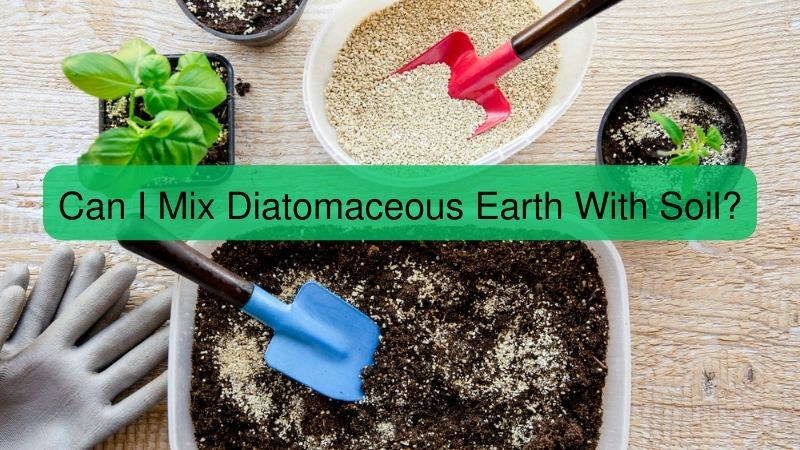When growing plants and caring for your garden, using the right soil types and additives can increase the productivity and health of your plants. One of the additives that is increasing interest to gardeners is diatomaceous earth. So, can I mix diatomaceous earth with soil? In this article, Garden Creatives will answer this question and provide detailed information about the benefits and how to use diatomaceous earth in gardening.
What is Diatomaceous Earth?
Diatomaceous earth, also known as diatomaceous earth, is a natural soil formed from ancient seaweed. Diatomaceous earth has a fine powder-like structure but has high water absorption ability, contains many trace minerals, and has natural drying properties. This is why it is widely used in agriculture and horticulture.
Benefits of Diatomaceous Earth in Gardening
Improves Drainage: Diatomaceous earth has the ability to absorb moisture and hold water well, but allows water to drain easily, preventing the soil from being waterlogged. This is especially useful for plants that need well-drained soil.
Provides Minerals: Diatomaceous earth contains many trace minerals such as silicon, calcium, magnesium, and iron, which help provide nutrients to plants and improve soil quality.
Pest Control: Diatomaceous earth has the ability to naturally control pests. The small particles in diatomaceous earth can damage the insect’s outer shell, helping to reduce pest numbers without the use of chemical pesticides.
Improves Soil Structure: When mixed with potting soil, diatomaceous earth helps loosen the soil and improve soil structure, helping plant roots grow strongly and absorb nutrients better.
Can I mix diatomaceous earth with soil?
Mixing diatomaceous earth with potting soil is simple and can bring many benefits to your garden. Here are the basic steps:
Prepare materials
Soil for planting: You can use garden soil or pre-purchased planting soil.
Diatomaceous earth: Purchase diatomaceous earth from garden or agricultural supply stores.
Clay
For best results, mix diatomaceous earth with potting soil in a ratio of 1:4 (1 part diatomaceous earth and 4 parts potting soil). If your garden soil is heavy and prone to waterlogging, you can increase the proportion of diatomaceous earth.
Stirred
Use a shovel or hoe to stir the soil and diatomaceous earth mixture well. Make sure the diatomaceous earth is evenly distributed throughout the potting soil.
Plant a tree
After mixing well, you can use this mixture to grow plants as usual. Make sure to water regularly and check soil moisture to adjust the watering amount accordingly.
Types of Plants Suitable for Diatomaceous Earth
Some plants can grow well when planted in a mixture of diatomaceous earth and regular potting soil. Here are some examples
Indoor Plants: Many indoor plants such as cacti, succulents, and Philodendrons grow well in diatomaceous earth because they need well-drained soil.
Vegetable Plants: Vegetables, lettuce, tomatoes, and peppers can also benefit from using diatomaceous earth, as they need well-drained, nutrient-rich soil.
Fruit Trees: Some fruit trees such as strawberries and blueberries can also grow vigorously when grown in soil mixed with diatomaceous earth.
Does Diatomaceous Earth Harm Plants?
So far, we have only had praise for this product, but is it really safe to use diatomaceous earth for plants?
Diatomaceous earth is completely non-toxic, not only to humans and pets but also to your plants. Therefore, you can use it without worrying about negative effects on your flower or vegetable consumption, as some other pesticides can cause.
However, it is important that you wear protective eyewear and perhaps even a mask when using this product. The dust from diatomaceous earth can be irritating to your lungs and eyes.
In terms of safety for your garden, growers often worry about tree roots. But you can rest assured that diatomaceous earth will not harm the roots of your plants. Simply leaving diatomaceous earth on the soil surface will not cause any harm to your plants.
How Often Should You Fertilize Diatomaceous Earth in Your Garden?
Using diatomaceous earth in the garden is effective thanks to its dry, sharp edges. However, when diatomaceous earth gets wet, it loses its effectiveness.
After watering the plant, the diatomaceous earth will dry out again, so there is no need to reapply after each watering.
However, diatomaceous earth should be applied every few weeks if you water 3-4 times per week. If you grow plants in an area with high humidity or frequent rain, you should re-fertilize more often to ensure the best results.
How Much can I mix diatomaceous earth with soil?
The first step is to read the label on the diatomaceous earth product to determine how much you should apply to the soil, as each product can be different and manufacturers often have specific instructions.
If you want to apply dry diatomaceous earth directly to the soil, wear gloves, a dust mask, and eye protection, then sprinkle it evenly on the soil surface. Be sure to sprinkle around the base of the plant and the edges of the pot.
This method is most effective when the soil is still moist after watering or after it has rained, as the moisture will help hold the diatomaceous earth in place.
Notes When Using Diatomaceous Earth
Do Not Overuse: Although diatomaceous earth has many benefits, it should not be overused. Using too much diatomaceous earth can cause the soil to become too draining, leading to a lack of moisture for the plant.
Use the Right Type: Be sure to use diatomaceous earth intended for agriculture and gardening. Diatomaceous earth used for other purposes such as filtering aquarium water may contain substances that are not suitable for plants.
Safe to Use: Diatomaceous earth in fine powder form can cause respiratory irritation when inhaled. Please wear a mask when handling diatomaceous earth to ensure health and safety.
Conclude
So, you can absolutely mix diatomaceous earth with potting soil. Not only does this improve drainage and provide additional nutrients to the plant, but it also helps control pests naturally. Try it out and experience the difference that diatomaceous earth makes to your garden. Surely, you will see plants grow healthier and your garden will become greener.





